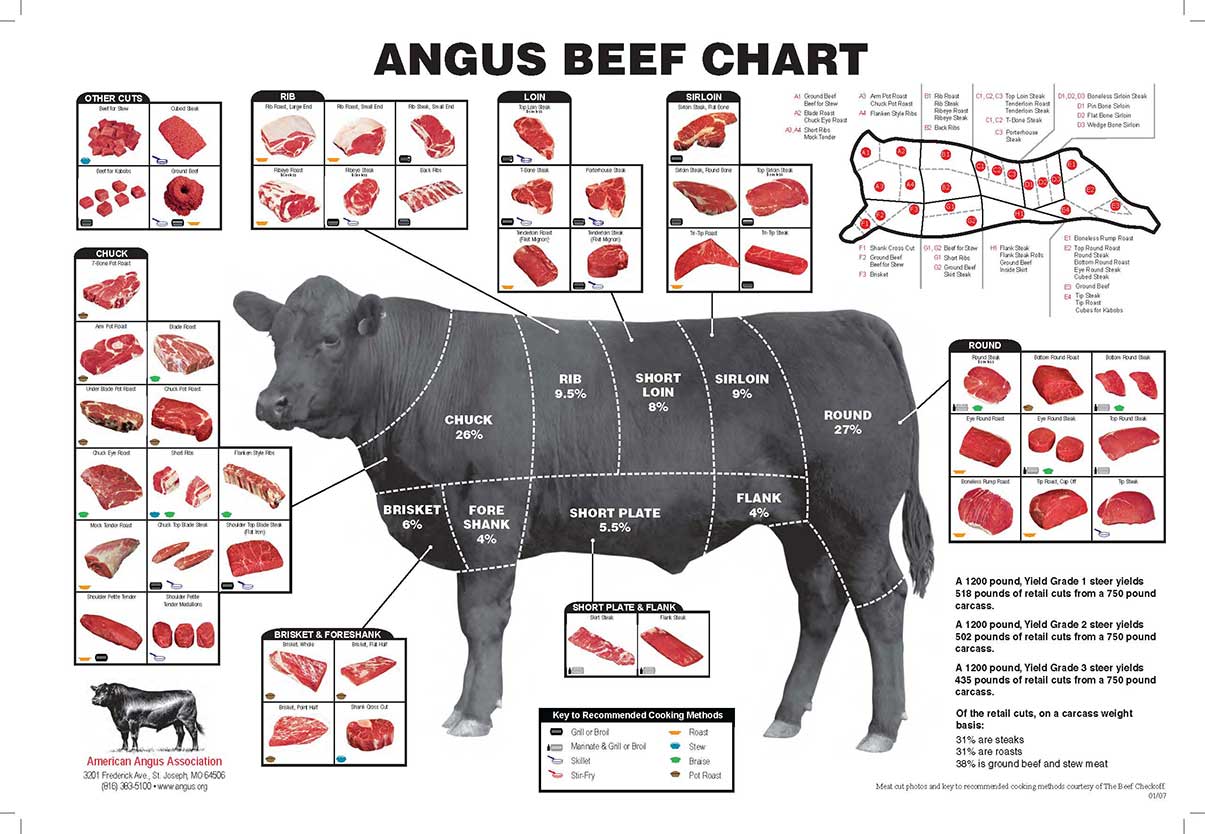Everything you need to know about sourcing and buying the highest quality grassfed beef at the best value for your family.
Your Guide to Buying Beef in Bulk.

2025 Pricing
+3.5% fee if paying with credit card, prices subject to change
Quarter
$ 16
Per PoundApprox. 100 lbsHalf
$ 15
Per PoundApprox. 200lbsWhole
$ 14
Per PoundApprox. 350-400lbsUnderstanding Bulk Pricing
HANGING WEIGHT – One of the most popular pricing methods for bulk beef is based on the animal’s hanging weight. This is the carcass weight, captured after the head, entrails, feet, etc are removed. Usually this has a slightly lower per-pound price because you are paying for the weight of the meat before it is dry aged (where moisture will be lost) and before the bones and trimmings from the cuts are removed.
FINISHED WEIGHT – Bar 3 prices our beef based on the finished weight. There’s actually a pretty significant loss between the animal’s hanging weight and the meat you take home. The carcass goes through a dry aging process, during which moisture is lost, and then as the meat is cut, bones, fat, and trimmings are also discarded. A 30%-40% loss from the hanging weight to the finished weight is very common–meaning that if the hanging weight was 700lbs, you could walk away with 300lbs less than what you paid for.
Is the Quality Worth the Price?
PROCESSING AGE – The age and size of a grass fed animal are extremely important factors when it comes to the development of the health benefits and taste. An animal that is under 20-24 months of age is too young and not fully grown eating only grass, and will likely lack the marbling and health benefits you expect from your grassfed beef. Most English breeds of cattle weighing less than 1000lbs are not full grown, which they must be in order to gain intramuscular fat during the finishing process—where the tenderness, flavor, and health benefits of grass fed beef are developed and stored—from calorically dense annual grasses.
GRASS FED & FINISHED – Many grassfed beef providers don’t actually go through a finishing process; however, this is a crucial step to developing marbling and flavor. Good genetics, fully grown, special annual grasses planted every year, mob or concentrated grazing, monitoring daily weight gain to insure the animal is “fattening” naturally, and no weeds! Doing these items for the last 60 days of the animal’s life are the key to success. Others will say “grassfed beef” but will finish the animal on grains or feed to develop marbling in the meat. Cattle are herbivores. They were never designed to eat grains. The healthy aspects of grass fed & finished beef comes from the green grass the animal eats. Vitamins A,D, and E, enzymes, Conjugated Linoleic Acid, and the proper balance of Omegas are just some of the benefits of grass fed & finished beef, in addition to having half the calories! The grasses used to finish are important, too. Perennial grasses will not provide the nutrition to gain enough weight in a short time. If the animal eats weeds, it’ll taste like weeds (usually a wild, gamey flavor) so closely monitoring the annual grasses for quality is essential for proper weight gain, marbling, and flavor.
HERD GENETICS – Certain breeds of cattle work better for grass fed programs than others. Has your producer ever had their beef graded as Select, Choice, or Prime? If an animal grades Choice, then the intramuscular fat is 4% or greater—this means your steak will be marbled, tender, and flavorful. Bar 3 has ultrasounded our herd to test for marbling. We have also DNA tested them for markers related to tenderness, docility, and marbling. This has allowed us to refine our herd to produce a consistent product.
Bringing Home Your Beef
HOW MUCH MEAT? – Most providers offer ¼, ½, or whole steer options. Of course, the final amount of meat you’ll receive depends on your provider. At Bar 3 Ranch, a ¼ is usually around 100 to 120 lbs of meat, most of which will fit in a small chest freezer (5.2 cubic feet). A standup freezer will easily hold a half, which is around 200 to 240 lbs of beef. A large chest freezer (22 cu ft) will easily hold a whole steer, usually around 400 lbs. You can expect about 20% grilling steaks, 30% ground beef, 30% briskets, ribs, roasts, and stew meat, and 20% cutlets, bone broth bones, meaty soup bones, osso bucco, etc.
HOW TO PICK YOUR CUTS – Most providers will let you give input into the cut sheet if you order a whole steer. This is where you can choose whether you want your Ribeyes to have the bone in or out, how thick your steaks should be, whether your brisket is kept whole for your smoker or cut to fit your crockpot, etc. If you’re unsure, just ask! Most providers have a standard cut sheet you can start with, or are at least happy to help guide you. Be sure to ask about organ meat if you don’t want it. Many producers will require you to buy all of the cuts that the animal produces, including organ meat. At Bar 3, we offer the organ meat separately, at a reduced price.
HOW IS IT PACKAGED? – Make sure you can get individual cuts of beef vacuum-sealed in properly labeled, airtight packages. That way you can easily inspect the meat before you thaw it. If it is airtight, it will last for 2 or more years in your freezer.
